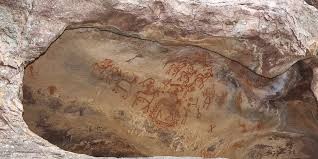Andhra Pradesh’s Second Largest Petroglyph Site
Andhra Pradesh’s second largest petroglyph site, containing about 80 petroglyphs, has been discovered at Mekala Benchi in Kurnool district.
- Kandanathi, with 200 petroglyphs, the biggest petroglyph site in Andhra Pradesh is also in Kurnool district.

- Petroglyphs are rock carvings (rock paintings are called pictographs) made by pricking directly on the rock surface using a stone chisel and a hammerstone.
- These Petroglyphs mostly have images of bulls or bull-riding, in addition to human figures, an elephant, tiger-like animals and cupules.
- While Mekala Benchi has petroglyphs dating back from the Neolithic to the Megalithic period, Kandanathi carvings range from the prehistoric to the historic period.
- The petroglyphs at Kandanathi reveal the presence of the Boya community divided into many exogamous groups such as Mandla (herdsmen) and Yenubothula (buffalomen).
Stone Ages
Palaeolithic (Old Stone) Age
- Basically a hunting and food gathering culture.
- Palaeolithic tools include sharpened stone, chopper, hand axe, scraper, spear, bow and arrow, etc. and were generally made up of hard rock quartzite.
- Rock paintings and carvings found at Bhimbetka, Madhya Pradesh reflect upon hunting as the main subsistence activity.
- Palaeolithic age in India is divided into three phases: Early or Lower Palaeolithic (50,0000 – 100,000 BC), Middle Palaeolithic(100,000 – 40,000 BC) and Upper Palaeolithic (40,000 – 10,000 BC).
- Homo sapiens mark their presence in upper palaeolithic age.
Mesolithic (Middle Stone) Age
- The age is marked by transition from Pleistocene period to Holocene period and favorable changes in the climate.
- The early period of Mesolithic age marks the hunting, fishing and food gathering.
- Domestication of the animals began in this age.
- The tools called Microliths were smaller and had improved geometry than the Palaeolithic age.
Neolithic (New Stone) Age
- Referred to as the concluding phase of the Stone Age, the age heralded the beginning of food production.
- Sedentism (living in one place for a long time) use of pottery, and invention of crafts are characteristics feature of neolithic age.
- The neolithic tools composed of heavy ground tools like pestles, grinders, pounders and also axes and sickles.
Megalithic culture
- Megaliths refer to large stone structures that were constructed either as burial sites or as commemorative sites.
- In India, archaeologists trace the majority of the megaliths to the Iron Age (1500 BC to 500 BC), though some sites precede the Iron Age, extending up to 2000 BC.
- Megaliths are spread across the Indian subcontinent. Majority of them are found in peninsular India, concentrated in the states of Maharashtra (mainly in Vidarbha), Karnataka, Tamil Nadu, Kerala, Andhra Pradesh and Telangana.